At the dawn of the atomic age,
uranium and thorium were equally important as the element of choice for nuclear
energy. Either one could have fuelled the world’s reactors. But it was uranium
that won out, and thorium, which is far cleaner, safer, denser and more
abundant than uranium, was relegated to the dustbin of science. With it went
the possibility of creating a low risk nuclear energy source to power our
planet. Now, as the world searches for cheap, non-carbon-emitting energy
sources, thorium is re-emerging as an overlooked solution that could provide
hundreds of years of clean, safe power.
The Thorium Advantage
More abundant: It is a naturally-occurring
element with very low radioactivity. Thorium is approximately three times as
abundant as uranium in the earth’s crust, reflecting that thorium has a longer
half-life.
Denser fuel: In addition, thorium
generally is present in higher concentrations (2-10%) by weight than uranium
(0.1-1%) in their respective ores, making thorium retrieval much less expensive
and less environmentally damaging per unit of energy extracted and generates
more energy per ton. The pro-thorium lobby claim a single tonne of thorium in a
liquid fluoride thorium reactor (LFTR), can produce one gigawatt of energy. A
traditional pressurised water reactor (PWR) would need to burn 250 tonnes of
uranium to produce the same amount of energy.
Nuclear safety: There is a safety side of
thorium reactions. Unlike U235, thorium is not fissile and does not undergo
chain reaction. To make thorium nuclei split apart, it must be bombarded with
neutrons. Then, when there is a need of shutting down the reaction, simply turn
off the source of neutrons and the whole process shuts down.
Manageable waste: In thorium based nuclear
reaction by-products are far less radioactive, which stays radioactive for only
500 years, instead of 10,000 years in the case of uranium.
Why are we using Uranium
Researches
related to nuclear reactions were initially driven not by the desire to make
energy, but by the desire to make nuclear weapon. Because the plutonium needed
to make fission devices come from reactors based of Uranium fuel. The $2
billion Manhattan Project that produced the atomic bomb sparked a worldwide
surge in nuclear research, most of it funded by governments embroiled in the
Cold War. The fact that Thorium reactors could not produce fuel (Plutonium) for
nuclear weapons, we discarded the much cleaner and safer Thorium.
Challenges for Thorium
One
of the biggest challenges in developing a thorium reactor is finding a way to
fabricate the fuel economically. Making thorium dioxide is expensive because
its melting point is the highest of all oxides, at 3,300° C. The options for
generating the neutrons needed to kick-start the reaction come down to uranium
or plutonium, making it uranium or plutonium dependent.
The Bottom Line
Thorium
is three times more abundant in nature than uranium. The concentration of
thorium is much higher in its ore, which means it does not require enrichment.
Thorium-based reactors are safer because the reaction can easily be stopped.
Compared to uranium reactors, thorium reactors produce far less waste and the
waste that is generated is much less radioactive and much shorter-lived.
To
top it all off, thorium would also be the ideal solution for allowing countries
like Iran or North Korea to have nuclear power without worrying whether their
nuclear programs are a cover for developing weapons.

No comments:
Post a Comment